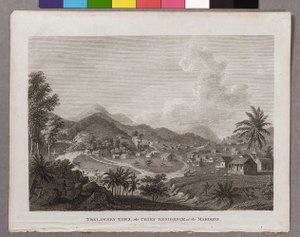
Back حرب المارون الثانية Arabic Segona Guerra Cimarrón Catalan Segunda Guerra Cimarrón Spanish Guerra dei cimarroni (1795-1796) Italian Sekan Maruun Waar JAM Second Maroon War Swedish
| The Second Maroon War | |||||||
|---|---|---|---|---|---|---|---|
| Part of the Atlantic Revolutions and the Slave Revolts in North America | |||||||
 Illustration of Trelawney Town | |||||||
| |||||||
| Belligerents | |||||||
| Maroons from Trelawney Town and allies | |||||||
| Commanders and leaders | |||||||
|
|
Montague James John Jarret Charles Samuels Andrew Smith Leonard Parkinson James Palmer | ||||||
| Strength | |||||||
| 5,000 | 150 Maroons,[1] 350 runaway slaves | ||||||
| Casualties and losses | |||||||
| At least 65 | 21–32 | ||||||
The Second Maroon War of 1795–1796 was an eight-month conflict between the Maroons of Cudjoe's Town (Trelawny Town), a Maroon settlement later renamed after Governor Edward Trelawny at the end of First Maroon War, located near Trelawny Parish, Jamaica in the St James Parish, and the British colonials who controlled the island. The Windward communities of Jamaican Maroons remained neutral during this rebellion and their treaty with the British still remains in force. Accompong Town, however, sided with the colonial militias, and fought against Trelawny Town.[2]
- ^ Michael Siva, After the Treaties: A Social, Economic and Demographic History of Maroon Society in Jamaica, 1739–1842, PhD Dissertation, African-Caribbean Institute of Jamaica library (Southampton: Southampton University, 2018), pp. 144–47, 176–77.
- ^ Mavis Campbell, The Maroons of Jamaica (Massachusetts: Bergin & Garvey, 1988), pp. 209–49.